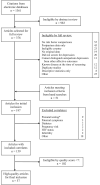Risk factors for depressive symptoms during pregnancy: a systematic review
- PMID: 20096252
- PMCID: PMC2919747
- DOI: 10.1016/j.ajog.2009.09.007
Risk factors for depressive symptoms during pregnancy: a systematic review
Erratum in
- Am J Obstet Gynecol. 2011 Sep;205(3):236
Abstract
The purpose of this study was to evaluate risk factors for antepartum depressive symptoms that can be assessed in routine obstetric care. We evaluated articles in the English-language literature from 1980 through 2008. Studies were selected if they evaluated the association between antepartum depressive symptoms and > or =1 risk factors. For each risk factor, 2 blinded, independent reviewers evaluated the overall trend of evidence. In total, 57 studies met eligibility criteria. Maternal anxiety, life stress, history of depression, lack of social support, unintended pregnancy, Medicaid insurance, domestic violence, lower income, lower education, smoking, single status, and poor relationship quality were associated with a greater likelihood of antepartum depressive symptoms in bivariate analyses. Life stress, lack of social support, and domestic violence continued to demonstrate a significant association in multivariate analyses. Our results demonstrate several correlates that are consistently related to an increased risk of depressive symptoms during pregnancy.
2010 Mosby, Inc.
Figures
Comment in
-
Perinatal screening for depression.Am J Obstet Gynecol. 2010 Aug;203(2):e16; author reply e17. doi: 10.1016/j.ajog.2010.02.017. Epub 2010 Apr 24. Am J Obstet Gynecol. 2010. PMID: 20417471 No abstract available.
References
-
- American College of Obstetricians and Gynecologists Committee opinion no. 343; psychosocial risk factors: perinatal screening and intervention. Obstet Gynecol. 2006;108:469–77. - PubMed
-
- National Collaborating Center for Mental Health . Antenatal and postnatal mental health: the NICE guideline on clinical management and service guidance. The British Psychological Society and The Royal College of Psychiatrists; London, Great Britain: 2007. - PubMed
-
- Dietrich AJ, Williams JW, Ciotti MC, et al. Depression care attitudes and practices of newer obstetrician-gynecologists: a national survey. Am J Obstet Gynecol. 2003;189:267–73. - PubMed
-
- Beck CT. A meta-analysis of predictors of postpartum depression. Nurs Res. 1996;45:297–303. - PubMed
Publication types
MeSH terms
Grants and funding
LinkOut - more resources
Full Text Sources
Medical
Miscellaneous


